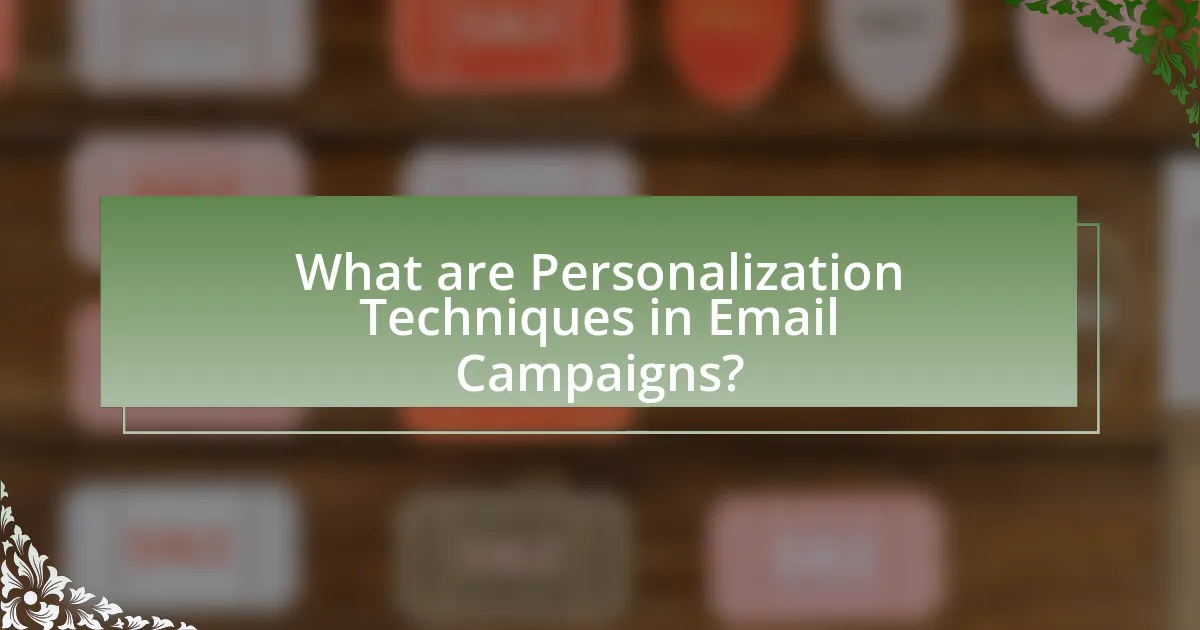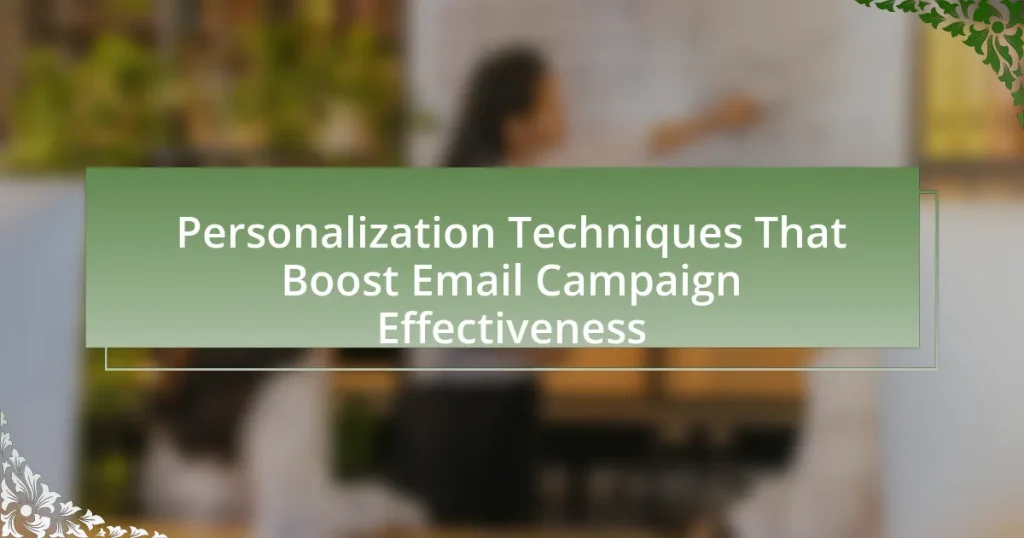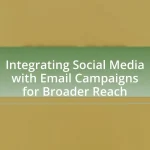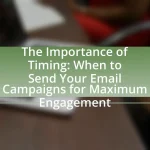Personalization techniques in email campaigns involve customizing content and messaging to align with individual recipient preferences, behaviors, and demographics. Key strategies include using the recipient’s name, segmenting email lists, and recommending products based on past interactions. Research indicates that personalized emails can significantly enhance engagement, with higher open and click-through rates, ultimately leading to increased transaction rates. The article explores various personalization methods, their impact on customer loyalty, and best practices for implementation, including the use of demographic and behavioral data, as well as automation tools to optimize email marketing effectiveness.

What are Personalization Techniques in Email Campaigns?
Personalization techniques in email campaigns involve tailoring content and messaging to individual recipients based on their preferences, behaviors, and demographics. These techniques include using the recipient’s name in the subject line or greeting, segmenting email lists to target specific groups, and recommending products based on past purchases or browsing history. According to a study by Experian, personalized emails can generate six times higher transaction rates compared to non-personalized emails, demonstrating the effectiveness of these techniques in enhancing engagement and conversion rates.
How do personalization techniques enhance email engagement?
Personalization techniques enhance email engagement by tailoring content to individual recipient preferences and behaviors. This targeted approach increases open rates, click-through rates, and overall interaction with the email. For instance, studies show that personalized emails can generate up to six times higher transaction rates compared to non-personalized emails. Additionally, using recipient names, past purchase history, and relevant recommendations fosters a sense of connection, making recipients more likely to engage with the content. This data-driven strategy not only improves user experience but also drives higher conversion rates, validating the effectiveness of personalization in email marketing.
What specific elements can be personalized in an email?
Specific elements that can be personalized in an email include the recipient’s name, subject line, email content, images, call-to-action buttons, and send time. Personalizing the recipient’s name in the greeting can increase engagement, as studies show that emails with personalized greetings have higher open rates. Customizing the subject line based on the recipient’s preferences or past behavior can also enhance relevance and improve open rates. Tailoring the email content to reflect the recipient’s interests or previous interactions can lead to better conversion rates. Additionally, using personalized images or offers based on demographic data can make the email more appealing. Adjusting the timing of the email send based on the recipient’s time zone or past engagement patterns can further optimize effectiveness.
How does personalization impact open and click-through rates?
Personalization significantly increases open and click-through rates in email campaigns. Research indicates that personalized emails have an open rate of 29% compared to 20% for non-personalized emails, and click-through rates can be as much as 41% higher. This effectiveness stems from the relevance of tailored content, which resonates more with recipients, leading to higher engagement. For instance, a study by Experian found that personalized subject lines can improve open rates by 50%. Thus, implementing personalization strategies directly correlates with improved performance metrics in email marketing.
Why is personalization important for email marketing success?
Personalization is crucial for email marketing success because it significantly enhances engagement and conversion rates. When emails are tailored to individual preferences and behaviors, recipients are more likely to open, read, and act on them. According to a study by Experian, personalized emails deliver six times higher transaction rates compared to non-personalized ones. This demonstrates that personalization not only captures attention but also drives measurable results, making it a key strategy in effective email campaigns.
What statistics support the effectiveness of personalized emails?
Personalized emails significantly enhance engagement, with studies showing that they can increase open rates by 26%. Additionally, personalized emails generate six times higher transaction rates compared to non-personalized emails. Research from Experian indicates that personalized subject lines improve open rates by 50%. Furthermore, according to a report by Statista, 80% of consumers are more likely to make a purchase when brands offer personalized experiences. These statistics collectively demonstrate the effectiveness of personalized emails in driving engagement and conversions.
How does personalization influence customer loyalty and retention?
Personalization significantly enhances customer loyalty and retention by creating tailored experiences that resonate with individual preferences. When businesses utilize data-driven insights to customize communications, such as personalized email campaigns, customers feel valued and understood, leading to increased engagement. According to a study by Epsilon, 80% of consumers are more likely to make a purchase when brands offer personalized experiences. This connection fosters trust and encourages repeat business, as customers are more inclined to remain loyal to brands that recognize their unique needs and preferences.

What are the Different Types of Personalization Techniques?
The different types of personalization techniques include demographic personalization, behavioral personalization, contextual personalization, and predictive personalization. Demographic personalization utilizes user data such as age, gender, and location to tailor content. Behavioral personalization analyzes user interactions, such as past purchases or browsing history, to customize recommendations. Contextual personalization adapts content based on the user’s current situation, like time of day or device used. Predictive personalization employs algorithms to forecast user preferences and suggest relevant content. These techniques enhance engagement and conversion rates in email campaigns by delivering targeted and relevant messages to recipients.
How can demographic data be used for email personalization?
Demographic data can be used for email personalization by tailoring content and offers based on characteristics such as age, gender, location, and income level. For instance, a marketing campaign can segment its audience into different demographic groups, allowing businesses to send targeted messages that resonate with each segment’s preferences and needs. Research shows that personalized emails can lead to a 29% higher open rate and a 41% higher click-through rate compared to non-personalized emails, demonstrating the effectiveness of using demographic data in email marketing strategies.
What demographic factors are most effective for targeting?
The most effective demographic factors for targeting in email campaigns include age, gender, income level, and geographic location. Age influences preferences and behaviors, with different age groups responding uniquely to marketing messages; for instance, millennials may prefer digital communication while older generations may favor traditional methods. Gender affects purchasing decisions and interests, allowing marketers to tailor content accordingly. Income level determines spending capacity, enabling targeted promotions that align with financial capabilities. Geographic location provides insights into cultural preferences and regional trends, enhancing relevance in messaging. These factors are supported by studies indicating that personalized marketing based on demographics can increase engagement rates by up to 29%.
How can businesses collect and utilize demographic data?
Businesses can collect demographic data through surveys, customer registration forms, and analytics tools. Surveys can be distributed via email or social media, allowing businesses to gather information such as age, gender, and location directly from customers. Customer registration forms on websites or during purchases also capture demographic details, while analytics tools track user behavior and demographics based on online interactions.
Utilizing this data involves segmenting email lists according to demographic characteristics, enabling targeted messaging that resonates with specific groups. For instance, a study by the Direct Marketing Association found that personalized emails can lead to a 29% higher open rate and a 41% higher click-through rate. By tailoring content to the preferences and behaviors of different demographic segments, businesses can enhance engagement and improve the effectiveness of their email campaigns.
What role does behavioral data play in email personalization?
Behavioral data plays a crucial role in email personalization by enabling marketers to tailor content based on individual user actions and preferences. This data includes metrics such as open rates, click-through rates, purchase history, and browsing behavior, which provide insights into what resonates with each recipient. For instance, a study by Epsilon found that personalized emails can lead to a 29% higher open rate and a 41% higher click-through rate compared to non-personalized emails. By leveraging behavioral data, marketers can create targeted campaigns that enhance user engagement and drive conversions, ultimately improving the effectiveness of email marketing strategies.
How can past purchase behavior inform email content?
Past purchase behavior can inform email content by enabling marketers to tailor messages based on individual customer preferences and buying patterns. By analyzing previous purchases, businesses can segment their audience and create personalized recommendations, increasing the relevance of the email content. For instance, a study by McKinsey found that personalized emails can lead to a 29% higher open rate and a 41% higher click-through rate compared to generic emails. This data underscores the effectiveness of leveraging past purchase behavior to enhance email engagement and drive conversions.
What tools can track user behavior for better personalization?
Tools that can track user behavior for better personalization include Google Analytics, Hotjar, and Mixpanel. Google Analytics provides insights into user interactions on websites, allowing marketers to analyze traffic sources and user engagement metrics. Hotjar offers heatmaps and session recordings, which help visualize user behavior on web pages, enabling targeted content adjustments. Mixpanel focuses on tracking user actions within applications, providing detailed analytics on user journeys and engagement patterns. These tools collectively enhance personalization strategies by delivering actionable data that informs content and marketing decisions.

How to Implement Personalization Techniques Effectively?
To implement personalization techniques effectively, businesses should leverage customer data to tailor content and experiences to individual preferences. This involves collecting and analyzing data such as purchase history, browsing behavior, and demographic information to create targeted email campaigns. For instance, according to a study by Experian, personalized emails can generate six times higher transaction rates compared to non-personalized emails. By segmenting audiences based on this data and using dynamic content that reflects individual interests, companies can enhance engagement and conversion rates.
What are the best practices for personalizing email content?
The best practices for personalizing email content include using the recipient’s name in the subject line and body, segmenting your audience based on demographics or behavior, and tailoring content to match the recipient’s interests or past interactions. Research shows that personalized emails can increase open rates by 26% and click-through rates by 14% (Experian, 2021). Additionally, utilizing dynamic content that changes based on user data enhances relevance and engagement, leading to improved conversion rates.
How can A/B testing improve personalization strategies?
A/B testing can significantly enhance personalization strategies by allowing marketers to compare different versions of content to determine which resonates better with specific audience segments. This method enables data-driven decisions, as it provides empirical evidence on user preferences and behaviors. For instance, a study by Optimizely found that A/B testing can lead to conversion rate improvements of up to 49% when tailored content is used based on user data. By analyzing the results of A/B tests, marketers can refine their personalization tactics, ensuring that email campaigns are more relevant and engaging to recipients, ultimately driving higher engagement and conversion rates.
What are common pitfalls to avoid in email personalization?
Common pitfalls to avoid in email personalization include over-segmentation, irrelevant content, and lack of testing. Over-segmentation can lead to overly narrow targeting, which may exclude potential customers. Irrelevant content occurs when the personalization does not align with the recipient’s interests or behaviors, resulting in disengagement. Lack of testing means failing to analyze the effectiveness of personalized emails, which can prevent optimization and improvement. According to a study by Experian, personalized emails can deliver six times higher transaction rates, emphasizing the importance of effective personalization strategies.
How can segmentation enhance personalization efforts?
Segmentation enhances personalization efforts by allowing marketers to tailor their messages to specific groups based on shared characteristics. This targeted approach increases engagement rates, as studies show that segmented email campaigns can achieve up to 760% higher revenue than non-segmented campaigns. By analyzing data such as demographics, purchase history, and engagement levels, businesses can create more relevant content that resonates with each segment, leading to improved customer satisfaction and loyalty.
What criteria should be used for effective email segmentation?
Effective email segmentation should utilize criteria such as demographics, behavior, engagement level, and purchase history. Demographics, including age, gender, and location, allow marketers to tailor content to specific audience segments. Behavioral data, such as website interactions and email open rates, helps identify user interests and preferences. Engagement level indicates how actively recipients interact with previous emails, guiding the frequency and type of content sent. Lastly, purchase history provides insights into customer preferences, enabling targeted promotions and recommendations. These criteria collectively enhance the relevance of email campaigns, leading to improved open and conversion rates.
How does segmentation improve targeting and relevance?
Segmentation improves targeting and relevance by allowing marketers to categorize their audience based on specific characteristics such as demographics, behavior, and preferences. This targeted approach ensures that messages resonate more effectively with each group, leading to higher engagement rates. For instance, a study by Mailchimp found that segmented email campaigns have an open rate that is 14.32% higher than non-segmented campaigns. By tailoring content to the unique needs and interests of each segment, businesses can enhance the relevance of their communications, ultimately driving better conversion rates and customer satisfaction.
What tools and technologies can assist in email personalization?
Email personalization can be significantly enhanced using tools and technologies such as Customer Relationship Management (CRM) systems, email marketing platforms, and data analytics software. CRM systems like Salesforce and HubSpot allow businesses to collect and manage customer data, enabling tailored email content based on user behavior and preferences. Email marketing platforms such as Mailchimp and ActiveCampaign offer features for segmenting audiences and automating personalized email campaigns. Data analytics software, including Google Analytics and Tableau, provides insights into customer interactions, helping marketers refine their strategies for more effective personalization. These tools collectively facilitate targeted messaging, improving engagement and conversion rates in email campaigns.
What are the top email marketing platforms for personalization?
The top email marketing platforms for personalization include Mailchimp, HubSpot, ActiveCampaign, and Klaviyo. Mailchimp offers advanced segmentation and personalized content features, allowing users to tailor messages based on subscriber behavior and preferences. HubSpot provides robust automation tools that enable personalized email workflows based on user interactions. ActiveCampaign excels in customer experience automation, offering deep personalization capabilities through its machine learning algorithms. Klaviyo specializes in e-commerce, delivering highly targeted email campaigns based on customer data and purchase history. These platforms are recognized for their effectiveness in enhancing email campaign performance through personalization techniques.
How can automation enhance personalized email campaigns?
Automation enhances personalized email campaigns by enabling the delivery of tailored content to individual recipients based on their behaviors and preferences. This technology allows marketers to segment their audience effectively, ensuring that each email resonates with the specific interests of the recipient. For instance, according to a study by Campaign Monitor, personalized emails can generate up to six times higher transaction rates compared to non-personalized emails. By utilizing automation tools, businesses can analyze customer data in real-time, trigger emails based on user actions, and maintain consistent engagement, ultimately leading to improved conversion rates and customer loyalty.
What are some practical tips for boosting email campaign effectiveness through personalization?
To boost email campaign effectiveness through personalization, segment your audience based on demographics, behavior, and preferences. This allows for tailored messaging that resonates with specific groups, increasing engagement rates. According to a study by Campaign Monitor, personalized emails can lead to a 26% increase in open rates and a 760% increase in revenue. Additionally, using the recipient’s name in the subject line and body of the email can enhance the personal touch, making the communication feel more direct and relevant. Implementing dynamic content that changes based on user data further personalizes the experience, ensuring that each recipient receives information that aligns with their interests and past interactions.




